Uncategorised
Is Contract Manufacturing in China Still Viable?

In today’s globalized world, businesses are constantly seeking cost-effective and efficient manufacturing solutions. Contract manufacturing in China has been a go-to option for many companies around the world due to its potential benefits.
However, with the changing economic landscape and geopolitical considerations, is contract manufacturing in China still a viable choice? In this article, we will delve into the advantages and disadvantages of outsourcing manufacturing to China and assess its current viability for businesses worldwide.
Understanding Contract Manufacturing in China
Before diving into the pros and cons, let’s define what contract manufacturing means. Contract manufacturing is the process of outsourcing production to a third-party manufacturer. Companies often opt for this approach to reduce costs, access specialized expertise, and focus on core competencies.
In the context of China, it involves collaborating with Chinese manufacturers to produce goods at a larger scale.
The Pros of Contract Manufacturing in China
Cost-Effectiveness and Labor Availability
One of the primary reasons businesses turn to China for contract manufacturing is its cost-effectiveness. China’s relatively lower labor costs allow companies to manufacture products at a competitive price. Additionally, the country boasts a vast pool of skilled and unskilled labor, offering ample workforce availability for large-scale production.
Technological Advancements and Expertise
Over the years, China has made significant strides in technological advancements. Partnering with Chinese manufacturers grants access to cutting-edge technology and specialized expertise, enabling businesses to produce high-quality products with the latest features.
Supply Chain Efficiency and Infrastructure
China’s well-established supply chain infrastructure plays a crucial role in efficient production and timely delivery of goods. From raw material sourcing to shipping logistics, the country’s well-oiled supply chain ensures a smooth manufacturing process.
Cultural and Language Considerations
China’s unique cultural perspective and language skills can prove advantageous for businesses with a global customer base. Manufacturers in China can better understand and cater to the preferences of diverse markets, ensuring products align with the needs of international consumers.
The Cons of Contract Manufacturing in China
Geopolitical and Trade Uncertainties
The geopolitical landscape can impact contract manufacturing in China. Trade tensions and policy changes between China and other countries may lead to uncertainties, affecting the smooth flow of goods and causing potential disruptions.
Quality Control Challenges
Maintaining consistent product quality can be challenging when manufacturing overseas. Businesses must invest in stringent quality control measures to ensure the products meet international standards and satisfy customer expectations.
Intellectual Property Risks
Protecting intellectual property rights can be a concern when outsourcing to China. Companies must take appropriate legal measures and work closely with manufacturers to safeguard their innovations and prevent counterfeiting.
Communication and Time Zone Differences
Effective communication is essential for successful contract manufacturing. Language barriers and time zone differences may lead to misinterpretations or delays in critical decision-making processes.
Environmental and Ethical Concerns
Outsourcing to countries with lax environmental regulations can raise ethical dilemmas. Businesses must be mindful of their environmental footprint and the ethical implications of their manufacturing choices.
Is Contract Manufacturing in China Still Viable?
With the pros and cons considered, the question remains: is contract manufacturing in China still a viable option for businesses? The answer varies depending on individual business needs, market conditions, and the ability to navigate the challenges associated with outsourcing to China.
Adapting to the Changing Landscape
While China continues to be a major player in contract manufacturing, businesses should adapt their strategies to account for evolving geopolitical and economic landscapes. Diversifying manufacturing locations and exploring other emerging markets can mitigate risks and enhance overall resilience.
Diversifying Manufacturing Strategies
Rather than relying solely on a single manufacturing location, businesses can consider a hybrid approach that involves diversifying their manufacturing strategies. Combining in-house production with strategic partnerships in different countries can offer more flexibility and reduce dependency on a single region.
Contract manufacturing in China still holds potential benefits, but it also comes with challenges, including geopolitical uncertainties, quality control issues, and ethical concerns. Businesses must carefully evaluate their unique needs and risk tolerance before deciding whether to opt for contract manufacturing in China or adopt a diversified manufacturing strategy. If you choose to work with an experienced manufacturer, you can be rest-assured. One like Shield Works is your perfect choice with their adequate experience and vast network of suppliers. Contact us now!
OEM Standards: Why They Matter and What They Are
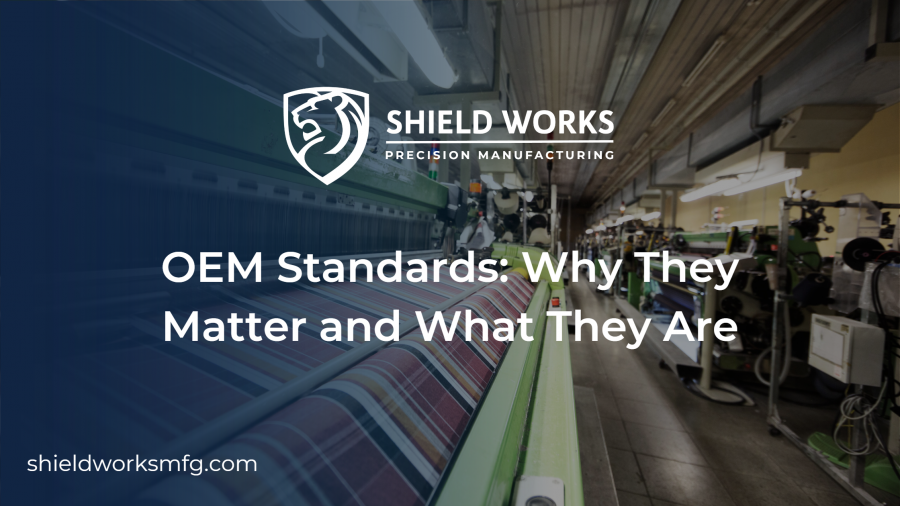
Original Equipment Manufacturer (OEM) standards are the requirements that manufacturers must meet when producing parts or components for a specific product.
These standards are set by the company that originally designed the product, and they outline the quality, safety, and reliability requirements that must be met in order for the parts to be considered acceptable for use in that product.
In this blog post, we will explore why OEM standards are important and how they impact product performance.
Why OEM Standards Matter
OEM standards matter for several reasons, including quality, safety, and reliability.
Quality
First and foremost, OEM standards help to ensure that products are of a consistent quality. By setting specific requirements for materials, manufacturing processes, and testing procedures, manufacturers can minimize variations in product quality and ensure that each component meets the same high standards.
This can help to improve the overall quality of products and increase customer satisfaction.
Safety
In addition, OEM standards are important for ensuring the safety of products. Manufacturers must comply with specific safety regulations and standards to ensure that their products are safe to use.
This may include requirements for components that are flame-retardant, non-toxic, or resistant to high temperatures, among other things. By meeting these safety standards, manufacturers can help to prevent accidents and injuries that may result from product failures or malfunctions.
Reliability
Reliability is another important factor that is impacted by OEM standards. By setting specific requirements for materials, manufacturing processes, and testing procedures, manufacturers can help to ensure that their products are reliable and perform as intended.
This can reduce the risk of product failures or malfunctions that can result in costly repairs or replacements, as well as damage to the manufacturer’s reputation.
In addition to these factors, complying with OEM standards can also have other benefits. For example, it can help manufacturers to streamline their production processes, reduce waste, and improve efficiency. It can also help to encourage innovation and the development of new technologies and methods that can improve product performance and reliability.
How OEM Standards Impact Product Performance
OEM standards play a critical role in determining the performance of a product. There are several ways in which these standards can impact product performance, including materials, manufacturing processes, and testing.
Materials
One of the most important ways in which OEM standards impact product performance is through the use of high-quality materials. This includes:
Material selection
Manufacturers must carefully select the materials used in their products, taking into account factors such as durability, strength, and resistance to wear and tear.
Material quality
The quality of the materials used can impact the performance of the product over time. Using high-quality materials can help to ensure that the product performs well and meets the specific needs of customers.
Manufacturing Process
Manufacturing processes also play a key role in determining product performance. This includes:
Consistency
Manufacturers must ensure that their manufacturing processes are consistent and repeatable in order to minimize variations in product quality and ensure that each component meets the same high standards.
Quality control
Techniques such as statistical process control, automated testing, and continuous improvement programs can help manufacturers improve product performance and reliability, and reduce the risk of defects or malfunctions.
Testing
Testing is another important aspect of OEM standards that impacts product performance. This includes:
Performance testing
Manufacturers must rigorously test each component to ensure that it meets specific performance criteria. This may include tests for strength, durability, resistance to temperature and humidity, and compatibility with other components in the product.
Environmental testing
In some cases, manufacturers may also conduct environmental testing to ensure that their products can withstand harsh conditions, such as extreme temperatures or exposure to saltwater. By conducting these tests, manufacturers can identify and correct potential performance issues before they become a problem for customers.
Design & Innovation
In addition to these factors, OEM standards can also impact product design and innovation. This includes:
Encouraging innovation
By setting specific requirements for materials, manufacturing processes, and testing procedures, manufacturers can encourage the development of new technologies and methods that can improve product performance and reliability.
Creating better products
This can lead to the creation of new products that meet the evolving needs of customers and perform better than previous generations. By staying up to date with OEM standards, manufacturers can create products that are safer, more reliable, and better suited to the needs of their customers.
Overall, OEM standards are important for ensuring the quality, safety, and reliability of products.
By setting specific requirements for materials, manufacturing processes, and testing procedures, manufacturers can improve the overall quality of their products, reduce the risk of accidents or injuries, and protect their reputation in the marketplace.
Whether you are a consumer, manufacturer, or regulator, understanding OEM standards is essential for ensuring the safety and reliability of the products we use every day.
At Shield Works, we understand the importance of OEM standards and the impact they have on product performance. With over 18 years of experience in the industry, we have a professional engineering team that can help you meet the ideal OEM specs and standards for your product. Contact us today to learn more about how we can help you meet your OEM standards and take your product to the next level.
Comparing OEM Manufacturing With In-House Production: Pros & Cons
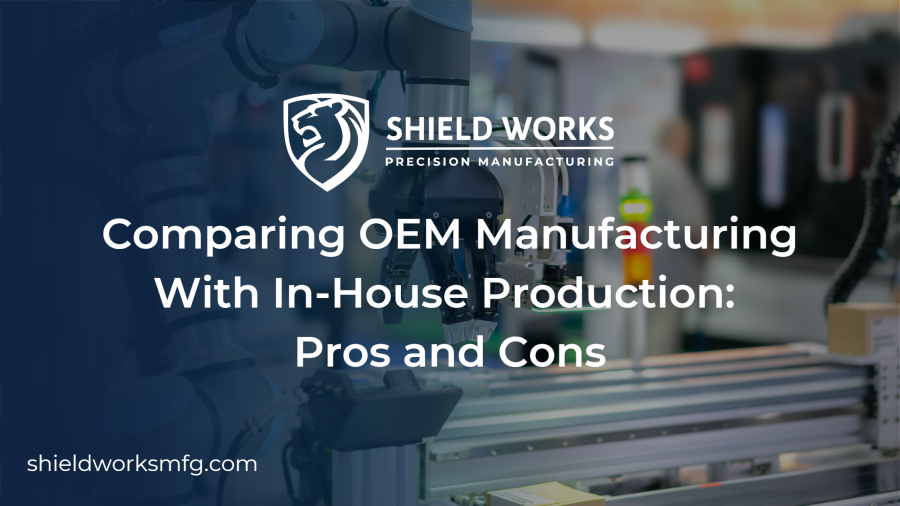
OEM (Original Equipment Manufacturer) manufacturing is a business model in which a company contracts with another company to produce parts or finished products that the first company will sell under its own brand.
In-house production, on the other hand, is the process of producing goods within a company’s own facilities, using its own resources and workforce.
Both OEM manufacturing and in-house production have their own set of benefits and challenges, and companies must weigh the pros and cons of each approach to determine the best fit for their needs.
Pros
Cost-Saving
One of the main benefits of OEM manufacturing is cost savings. OEM manufacturers often have specialized equipment and processes that allow them to produce goods more efficiently and at a lower cost than companies that produce goods in-house.
This can be particularly beneficial for companies that do not have the resources or expertise to produce certain products themselves.
OEM manufacturing can also allow companies to scale their production more quickly, as they can leverage the existing production capacity of their OEM partners rather than building and maintaining their own facilities.
Focused on Core Competence
Another advantage of OEM manufacturing is the ability to focus on core competencies. By outsourcing non-core production activities to OEM partners, companies can free up resources and focus on their core competencies, such as research and development, marketing, and sales.
This can help them to be more competitive and innovative in their market.
Cons
Loss of Control
However, there are also some potential drawbacks to OEM manufacturing. One concern is the potential loss of control over the production process.
When companies outsource production to OEM partners, they may have less visibility into and influence over the production process, which can lead to issues with quality, delivery, or compliance.
It is important for companies to carefully manage their OEM relationships and establish clear lines of communication and expectations to minimize these risks.
IP Risk
Another challenge of OEM manufacturing is the potential loss of intellectual property. When companies share their designs and technology with OEM partners, there is a risk that this information could be leaked or copied. To protect their intellectual property, companies must have strong contracts in place and carefully manage their relationships with OEM partners.
However, in-house production can also be more expensive than OEM manufacturing. Companies must invest in their own production facilities, equipment, and workforce, which can be a significant upfront cost.
In-house production can also be less flexible than OEM manufacturing, as it requires a more permanent and fixed production capacity. This can be a disadvantage for companies that need to scale their production up or down quickly in response to changes in demand.
Why a Good OEM Manufacturer Can Help You Overcome These Drawbacks
There’s always a solution to every problem. How to overcome these OEM challenges so that you can minimize the risk and fully enjoy its benefits?
One effective way is to work with an OEM manufacturer. Let the professional do their work.
But how to ensure that your product is in good hands? Here are a few key qualities to look for:
Strong communication
A great manufacturing company will have strong communication processes in place to ensure that there are clear lines of communication and expectations between the company and its OEM partners. This includes regular updates on production progress, alerts about any potential issues, and an open-door policy for addressing concerns or questions.
Quality control
A great manufacturing company will have robust quality control processes in place to ensure that the products they produce meet the standards of their clients. This may include measures such as inspections, testing, and certification to ensure that products meet relevant quality, safety, and regulatory standards.
IP protection
A great manufacturing company will have strong processes in place to protect their clients’ intellectual property. This may include measures such as non-disclosure agreements, licensing agreements, and technology transfer agreements to ensure that clients’ designs and technology are kept confidential. A great manufacturing company will also have robust processes in place to prevent the unauthorized use or reproduction of clients’ intellectual property.
Compliance
A great manufacturing company will be compliant with relevant laws and regulations, including labor laws, environmental regulations, and intellectual property laws. This ensures that their products are produced ethically and sustainably, and helps to protect their clients’ intellectual property.
Flexibility
A great manufacturing company will be flexible and able to adapt to changing customer needs and market conditions. This may include being able to scale production up or down quickly in response to changes in demand or offering custom solutions to meet specific needs.
Innovation
A great manufacturing company will be innovative and constantly seeking ways to improve their processes and products. This may include investing in new technologies, implementing lean manufacturing principles, or developing new products and services.
In conclusion, both OEM manufacturing and in-house production have their own set of benefits and challenges. Companies must carefully weigh the pros and cons of each approach to determine the best fit for their needs.
If you are looking for a great OEM manufacturer that check all the boxes of the aforementioned criteria, look no further than Shield Works. Our transparency, flexibility and integrity are proven by our over 17 years in the industry and our IP-Protective Production Zone. Contact us now!
Is Product Development in China Up to Snuff?
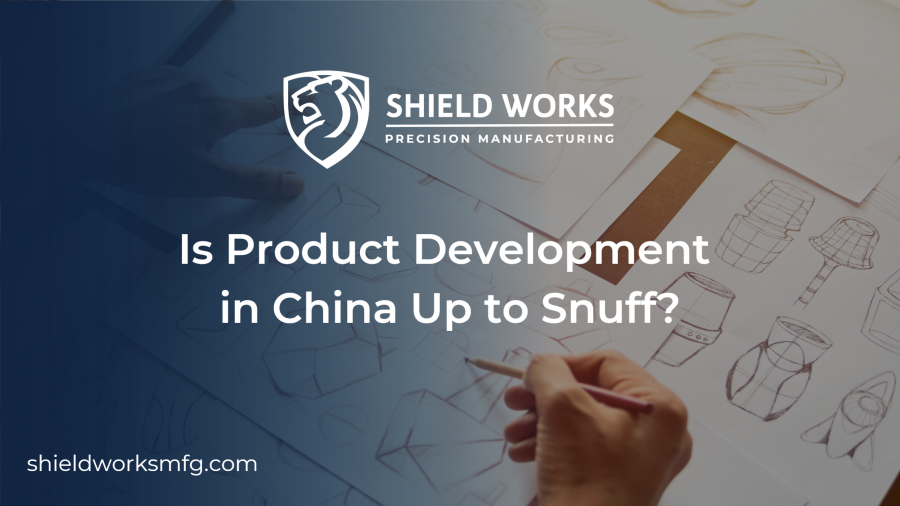
Product development in China has earned itself a reputation as one of the most innovative nations in the world. But just how good are the products that come out of China? Are they up to snuff? Some business owners find themselves questioning the value of outsourcing their product development needs to China, so let’s take a look at how the country stacks up against others when it comes to producing products that meet global standards.
It is still a good idea to outsource product development to China
The idea of outsourcing product development to China may seem strange to many. Most engineers and product developers assume that manufacturing abroad only applies to sourcing parts from other countries, but there are many advantages to having your invention made in China. Chinese companies, for example, often provide ready-made factories, so you don’t have to worry about setting up the factory space before production begins. The biggest benefit of outsourcing product development is the cost savings. there are generally cheaper manufacturing costs in Asian countries than in Western ones, which allows startups to take risks they otherwise wouldn’t be able to.
With years of development, China is able to produce quality products that meet international standards. Engineers and product developers think outsourcing manufacturing to China is a risky decision, since they are concerned about the quality of the products. American brands are realizing, however, how reliable Chinese companies can be as more use them for their projects.
Get off to a good start
Working with a partner who has impeccable standards and experience is the best way to avoid quality issues in the future. In spite of the numerous problems that can arise when making products abroad, you’ll want someone on your team who can spot these problems before they snowball. Working with an experienced partner will help you avoid major setbacks, whether it’s minor translation errors or hardware problems. Know what aspects of your product or business could cause problems. When unsure of anything regarding your production process, consult an expert or do some research.
For example, if you’re using a new material or technology for your product, it’s critical to know how that material will interact with other components. Whether you’re making a hard drive, an electronic device, or anything else that contains moving parts and circuits, you need someone who knows how these things work together. This can help you avoid quality issues that may arise later during production when pieces are put together in different locations around the world.
How long it takes
From preparing a prototype and testing it, to finding materials and ordering samples, bringing an idea to life can take up to six months on average. Consequently, product development timelines are dependent on various factors such as the creation of a custom mold instead of a mass-produced mold or production in China. This could result in significant changes in the timeline, depending on your design and goal. What will the timeline be for receiving your samples? It will vary based on what type of shipping you select. Ordering standard delivery is good for packages to reach you in two weeks or less; order express shipping and you’ll receive your package in one week.
But with COVID and geopolitics, everything still remains more or less unclear. It’s important to have an adaptable mindset.
How much you should invest prototyping
Getting prototypes made is often a great way to see how your product will look (and feel) and how durable it will be. It’s also worth taking into account the fact that prototypes have varying prices. If you are looking for low-cost prototyping solutions such as 3D printing, get quotes from multiple suppliers. Injection-molded parts can cost hundreds to thousands of dollars. Many manufacturers don’t charge their first-time clients much for printouts if cooperative desire is demonstrated.
It’s also important to consider how many products you will make. If you’re only going for one prototype, that might not be a bad place to start. But if you are trying to test multiple variables or aspects of your product idea, investing in several iterations could make sense. (For example, if you want both male and female feedback on a product before going into production.)
How to make sure you don’t get ripped off
Although you may be hesitant to send money to a company you don’t know, most clients choose to have an agreement in writing before making any payments. The agreement should include timelines for delivery, agreements for delayed shipping and detailed specifications. If you’re worried about your contract being followed to the letter, hire a lawyer who works in this area, or find a partner that has experience making goods in China. That way you can rest assured that there will be no mix-ups, you’ll get exactly what you wanted, and there’ll be less chances for headaches.
If you don’t have time to vet a partner thoroughly before entrusting your project to them, you could run into some problems, but investing your time up front into researching reputable ones will solve the majority of potential issues. From the UK and with a 17-year history in product development, Shield Works definitely understands your language. Give us a call and find out more!
Why China is the Top Country for Product Prototyping

Although there are prototyping services in numerous countries around the world, China provides one-of-a-kind advantages to entrepreneurs and manufacturers alike. Let’s take a look at why China is the best place to prototype products before they launch globally.
Labor cost is lower
While labor costs in China are still cheaper than those of other high-tech economies like Japan and South Korea, they use more advanced machinery and better manufacturing processes to make products cheaper, faster, and higher in quality. Allowing these firms to set lower prices, such efficiency come from better use of technology (like robots) and closer monitoring of labor schedules to minimize downtime (i.e. breaks taken by workers). These different factors increased efficiency and lower wages, which mean that Chinese manufacturers are capable of supplying a higher quantity of products at a lower cost than anywhere else in the world.
They take care of it all
Some Chinese prototyping shops provide all the help you need to build a prototype. On-staff designers, 3D printers, and injection molders will give your ideas form and shape. if you purchase a package deal, they’ll do all of your work for you. Startup founders love this because it lets them focus on what they do best. Even better: specialized prototyping companies are popping up in increasing numbers, with faster-than-normal manufacturing processes, which work well for small startups aiming to get specific things accomplished.
For example, if you’re building a medical device, you might want to partner with a firm that specializes in the design and manufacture of medical devices. These firms know the details that the regulatory agencies such as FDA need to make sure that you’re following their protocols and as such you don’t need to concern yourselves with that information. Entrepreneurs who are launching hardware-based products should work closely with these experts from the earliest phases of the project.
Fast delivery
Inexpensive prototyping and large-scale manufacturing allow product developers to innovate at an unprecedented pace. Chinese factories offer lower costs, shorter lead times, and larger production volumes than other countries. Companies like Apple have established relationships with Chinese manufacturers for over a decade. Today, a large percentage of Apple’s products are manufactured in China—including final assembly for some parts (e.g., cables and batteries). While there are many factors that come into play when deciding where to locate production, high speed of prototype delivery has become increasingly important as consumers demand better turnaround times on pre-orders.
Preloaded technology
Since they make 3D printers with helpful software to make them easier to use, Chinese manufacturers also preload their 3D engineers with more industry experience, because they typically hire skilled workers who are experienced with manufacturing similar products or work with experienced consultants. Due to its large population, the talent pool in China is nothing comparable to those in other countries. It’s been difficult to close this sizable gap.
Innovative culture
While in the past China’s reputation has been that of a country that has stolen technologies and has relied on a copier culture, it’s now on the verge of becoming a leading economic power. Beijing’s top leaders are beginning to think that innovation, not imitation, can be the solution to some of the country’s problems and that it can create new industries and jobs, as well. They believe that innovation will lead to economic growth and more opportunities. nearly 700 universities in China have revamped their names to incorporate innovation, signifying an emphasis on teaching for research and development. Only a few years ago, these schools focused solely on providing the lowest common denominator of engineering training, churning out manufactured products for countries around the world.
Home-made tech forces
One of the reasons why Chinese startups can prototype at such an accelerated rate is that they take advantage of local tech hubs. These facilities allow startups to rent office space, equipment, and more–eliminating expensive overhead costs while also fostering a sense of community and support. For a tech startup’s success in prototyping its product, being closer to industry experts and resources as well as proximity to large financial markets might be just as important as proximity to Silicon Valley’s startups and innovation.
For instance, take Huaqiangbei in Shenzhen for prototyping needs. With processors, motors, sensors, and circuit boards, this massive market has all of the electronic components imaginable. This place would be like a godsend for an entrepreneur! Don’t worry, those needing a startup engineer or product designer needn’t walk the thin line of distributors or manufacturers – they can take to the equally harrowing but far shorter task of searching Huaqiangbei Street instead! Of course, they also gain an attractive other benefit, though access to information.
Shield Works’ in-house engineering team is well-seasoned and bilingual, and we have over 17 years of product prototyping experience in China. Contact us now for more!
Top 5 Tips of Ensuring Smooth Communication with Your Chinese Manufacturer

It’s easier than ever to get your products manufactured in China, with resources such as Alibaba, Quora, and Google Translate at your disposal. But having a reliable Chinese manufacturer isn’t just about knowing how to communicate with them; it’s also about understanding how the whole process works and what your role is in it. Here are the top five tips for ensuring smooth communication with your Chinese manufacturer to help you get started.
1) Have a clear idea of what you want
Before you go contacting manufacturers in China, spend some time to really figure out what it is that you want. Don’t just say I want a cheap product made in China. Get specific. Look at different products that are similar to yours and decide exactly how your product will differ. And if there are aspects of your product that can be improved upon, do it! It’s always a good idea to outdo your competition. The more detail you put into your product from start to finish, the better off you’ll be when it comes time to communicate with your manufacturer.
Find a model or sample if you can for reference. A picture is worth a thousand words, and seeing exactly what you want will help your manufacturer understand exactly what it is that you’re looking for. They may even be able to point out design flaws in your product that you hadn’t considered before! It may seem like an extra step, but it could save time and money in the long run.
If your product requires any specialized parts, make sure to get those details sorted out early on as well. If there are specific types of wood that need to be used or special kinds of metal, make sure to clarify that from day one so there aren’t any problems later on down the line when it comes time to actually produce your product.
2) Be clear on expectation and deadlines
If you’re planning to work with a Chinese manufacturer, make sure your requests are as clear and specific as possible. Make deadlines clear and enforceable, otherwise there is no incentive for your team to stick to them. If a situation arises that requires changes or exceptions, have a separate process in place (such as checklists) to make sure everyone on both sides knows what’s going on. Good communication saves time and money—two things every business wants more of.
That’s why it’s advisable to find a manufacturer with their own production facility, preferably in the same city or anywhere within three-hour drive. This way you can easily check on your products and make sure everything is going according to plan. It also means that you don’t have to worry about shipping costs and delays from faraway locations. Finally, if something goes wrong, you’ll be able to respond quickly—and save face by fixing things before they get out of hand.
3) Know how the factory and its QC operates
We can’t emphasize enough how important it is to build an in-depth understanding of how your factory runs and what your QC protocols are. A deep understanding will help prevent issues, save you time and money, as well as help you work more effectively throughout your manufacturing process. There’re so many independent vetting services in China you can turn to. You’ll find them on Alibaba or by Googling independent QA checker or independent quality control checker. You’ll also want to make sure you understand exactly who your QC inspector is and that they have a good track record of working with other western companies. If you don’t know who they are, ask! Ask to speak directly with them or their supervisor if possible. It’s better to be safe than sorry when it comes to communication breakdowns between yourself and your manufacturer!
Although there’re many independent QC services with a history of working with western firms, if you insist on one that shares a similar cultural background with you, Shield Works has its root in the UK with years of QC experience in the industry that you can fully rely on.
4) Get someone local in China that you can talk to
Even if you don’t speak Mandarin, there are still ways to ensure you get your message across. If you’re traveling to China yourself, a translator is a must-have. But given the current travel restrictions, it is not an option to physically be there. So what do you do? You can hire someone local in China that can act as a liaison between you and your manufacturer. They should have experience working with Westerners and can translate information from both sides of communication (i.e., from English to Mandarin and vice versa). They will help bridge any language barriers that may exist and make sure everyone is on the same page regarding deadlines, expectations, etc. This will help reduce confusion and miscommunication that could lead to delays or other issues down the road.
But most manufacturers there now have bilingual team members that have no problem communicating with you in your language. if you manage to find one with a western background like Shield Works, that’ll save you a lot of efforts!
5) Keep your language plain and simple
This may seem obvious, but be sure to speak clearly and concisely. If there’s anything you don’t understand about what you need to accomplish or convey, don’t guess or fill in gaps with assumptions. If a word confuses you, go back and get clarification. Try to avoid using big words as it can make it harder to understand for non-native speaks. Keep your language simple
Remember that your goal is communication—not simply understanding what someone is saying to you. Successful communication requires that both parties feel confident they have a full understanding of one another’s intentions before moving forward on any project or task. Otherwise, confusion will quickly ensue; misunderstandings can lead to delays and even make-or-break moments down the road. The more time you spend ensuring that everyone understands each other, the less time it takes to complete tasks. A little upfront work now can save a lot of headaches later.
By following these five tips, you’ll be on your way to having a smooth process of communication with your manufacturer and start working together to create a great product. Shield Works is one that comes with their own manufacturing facility located exactly where the headquarter is, and bilingual team members as long as 17 years of manufacturing in China under their belt. Contact us today!
5 Tips For Reducing Costs On Quality Control In China
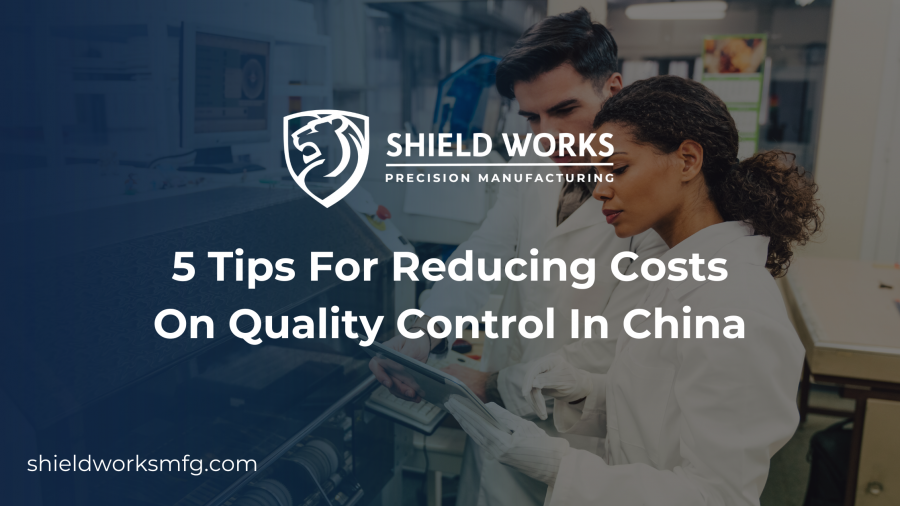
Whenever you’re sourcing products in China, it’s always a good idea to have quality control measures in place. These will ensure that your products are as strong and durable as they need to be, so that customers continue to buy them and recommend them to their friends and family members. However, it can often be difficult to save money on quality control when working with Chinese suppliers. Here are five tips for reducing costs on quality control in China.
1) Use 3rd-Party Inspection Services
Third-party inspection services will typically charge a fee for their services but will also help streamline communication between your factory and yourself. They’ll also help prevent any language barriers from interfering with communication. A third-party inspector will typically visit your production facility once per month during production runs, which means you’ll still need to conduct regular inspections via Skype or other methods yourself throughout each month. But by using third-party inspectors regularly throughout production cycles, you can ensure that problems don’t go unnoticed until after goods have been shipped off to customers. When it comes to quality control in China, a little bit of extra effort now could save you thousands of dollars later on.
2) Build Relationships With Suppliers
Your China manufacturing operation is only as good as your supplier relationships. That’s a fact. When suppliers deliver on time, meet quality requirements and are flexible when you need them to be, then you can feel confident in putting your product in front of consumers. But if a supplier flubs an order (or multiple orders), doesn’t pay attention to details or otherwise cuts corners that affects quality, it will be reflected in customer perception of your brand—and eventually sales results. Unfortunately, there’s no simple solution here because every situation is different, but there are ways to help minimize risk of problems with suppliers and still find high-quality products at a price point that makes sense for your business. Having a solid relationship with your China manufacturer will help ensure all goes well from start to finish so as to save for quality control later.
3) Find Suppliers You Can Talk To
As we just mentioned, it’s crucial to build a good relationship with your suppliers. If you have a supplier that will work closely with you, you will have peace of mind knowing that your products are being built as per your specifications and on time. This can save you thousands of dollars in unnecessary costs on quality control inspection and rework if your supplier is lax about following instructions. Since many China manufacturers don’t speak English well, try to find someone who can understand what you need or use an agency or translator who specializes in working with Chinese manufacturers. Also make sure to check references before doing business with any new supplier.
4) Get Critical Feedback While Your Product Is Being Manufactured
One of the biggest mistakes entrepreneurs make when manufacturing a product is assuming that everyone is as invested in its success as they are. But often you’ll be working with multiple vendors, each responsible for a different component of your finished product. Without directly collaborating with all vendors, it can be hard to spot inconsistencies—like inferior fabric or mismatched parts—until too late in production. The easiest way to catch these and other problems early on is by getting critical feedback from suppliers and manufacturers while your product is being made. While it’s impossible to ensure perfection, taking advantage of communication can help limit any mishaps during production so they don’t cost you time or money later down the line.
5) Get Involved in the Production Process
When you’re manufacturing overseas, quality control is a crucial issue. If there are quality issues with your product or manufacturing process, that means you will lose time, money and a lot of reputation. The best way to overcome quality problems is to get involved in QC yourself. A first step would be to try testing out parts of your production process at each stage before you send it off for mass production. This will make sure that whatever defects happen are caught early on and can be corrected as early as possible, with minimal cost and effort. With current travel restrictions, most likely you won’t be physically there in China. Make sure to find one that can livestream the whole process or any trusted 3rd-party inspection services to test it out for you.
Overall, quality control is one of those things that may seem small in terms of overall costs and time, but it can make a significant difference to your bottom line in both ways. It’s never too early or too late to start improving your QC. Shield Works has over 17 years of QC experience with our own professional team, contact us if you are in need of QC service in China!
How Outsourcing Product Assembly to China Benefits Your Electronic Manufacturing
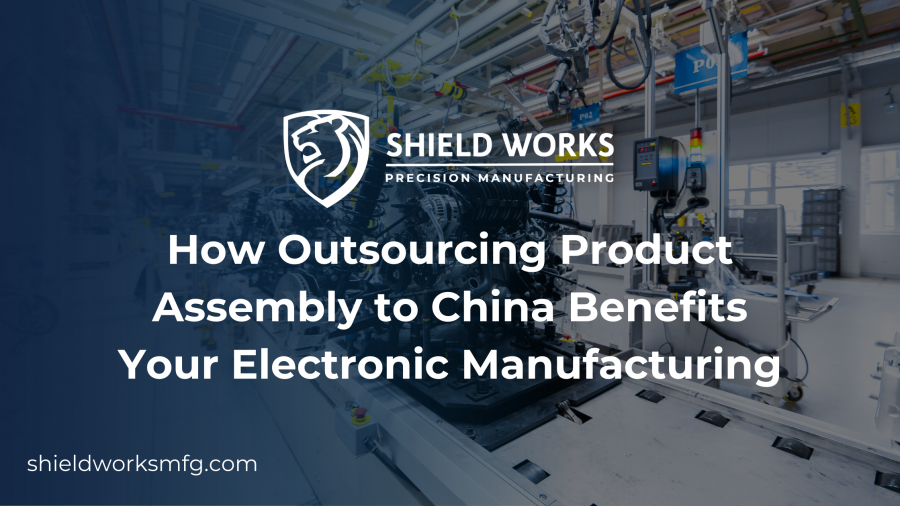
If you’re planning to manufacture and assemble electronics overseas, you might be wondering how outsourcing your product assembly to China can benefit your business. There are many benefits that come with manufacturing in China including lower costs, shorter lead times, and higher quality of products. These are just some of the perks of outsourcing product assembly to China that you should know about when deciding where to base your manufacturing operations or e-commerce distribution center. You can find out more about these advantages below.
Reducing Costs
According to a study from 2005, China has one of the highest costs of labor in Asia. However, other studies suggest that shipping products across oceans makes China an attractive location for manufacturing in terms of overall costs. Either way, saving money on product assembly will help your bottom line immensely. Manufacturers outsourcing their assembly process are typically able to cut between 20% and 50% off their product cost; without outsourcing, you could probably make a very similar product at a cost-per-unit profit comparable to or even greater than that of your competitors. It’s no wonder why so many manufacturers have chosen to outsource product assembly: The benefits are clear.
Improving Time to Market
It’s no secret that time-to-market is a major factor in determining success for new products. Starting with a lean manufacturing strategy can really improve your company’s ability to quickly get products onto store shelves and out into homes. Before you start building your product, consider if it makes sense to outsource product assembly or even electronics manufacturing. If done correctly, outsourcing certain parts of production can make prototyping faster, reduce costs and improve overall efficiency in product assembly and time-to-market. In addition, outsourcing electronics manufacturing overseas may allow you access to better talent at lower costs than you’d find domestically.
Improving Quality Control
One of the most important aspects of electronic manufacturing is your company’s quality control. All products, regardless of complexity, have at least one critical element that keeps them working properly: a single connector or set of wires, an integrated circuit or a battery. You must take special care when making these elements because any mistake can mean disaster for your customers. That’s why hiring outsourced workers to manufacture your product assembly allows you to retain more control over production than you would in-house manufacturing: When someone is actually constructing a product on your behalf in another country, they know they only have one shot at creating something that works perfectly every time—or it’s not going back on an airplane with them.
Increasing Customer Satisfaction
When it comes to outsourcing, customer satisfaction is just as important as cost. The most common mistake of new electronics manufacturers is trying to save money by selecting a vendor that cuts corners. This can lead to a lot of headaches further down the line, including returns and re-work. Start off right by finding an experienced partner with a proven track record in product assembly and electronic manufacturing services. You’ll have greater peace of mind knowing that you’re on your way to growing a successful business—not just doing business in China. Also, its time-saving benefit can also contribute to better customer satisfaction by keeping your design team focused on what they do best – designing new products! There’s nothing worse than spending hours making minor tweaks to an existing product when there are millions of dollars worth of opportunities out there just waiting for a new idea. Product design is where you’ll see huge improvements by hiring experienced engineers and designers with experience working with complex electronics like yours.
Helping Understand the Chinese Electronics Manufacturing Ecosystem
In China, product assembly work can be done through a large number of vendors. As a result, you have many different firms that are capable of handling specific tasks in your manufacturing process. To benefit from these resources, it is important to understand how they fit into the Chinese electronics ecosystem and what services they can provide. But to grasp each type of organization involved in electronics manufacturing in China can be very challenging for someone new to the country. It will be much easier for you to find an outsourced partner that can complete a specific stage of your production line and bridge all the gaps together with other departments for the output of quality products.
Shield Works is one of your best choices with a self-owned IP protected, in-house bilingual engineering team and over 16 years of experience of manufacturing in China for clients worldwide, including product assembly. Please feel free to contact us if you are interested.
